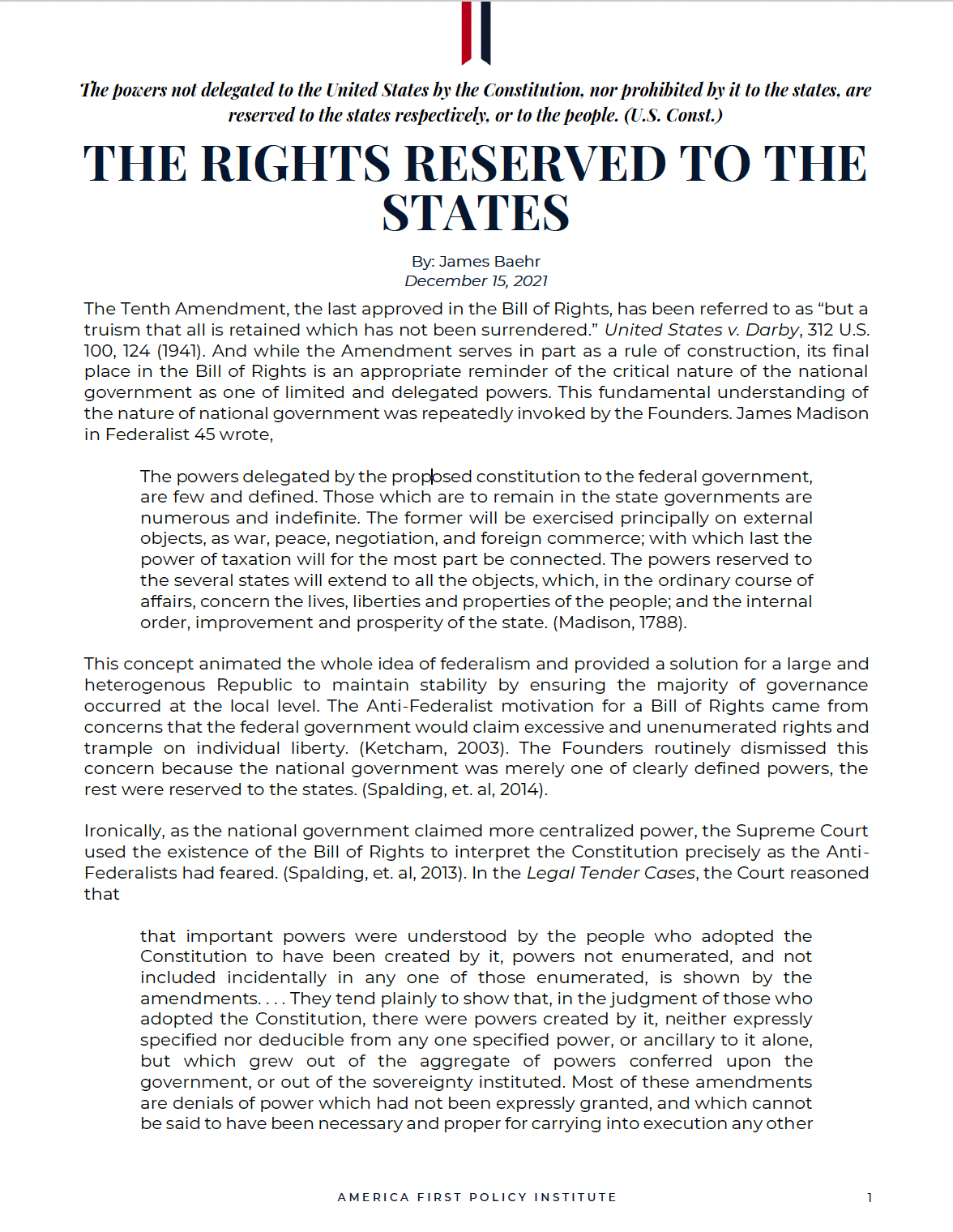The Rights Reserved to the States
The powers not delegated to the United States by the Constitution, nor prohibited by it to the states, are reserved to the states respectively, or to the people. (U.S. Const.)
The Tenth Amendment, the last approved in the Bill of Rights, has been referred to as “but a truism that all is retained which has not been surrendered.” United States v. Darby, 312 U.S. 100, 124 (1941). And while the Amendment serves in part as a rule of construction, its final place in the Bill of Rights is an appropriate reminder of the critical nature of the national government as one of limited and delegated powers. This fundamental understanding of the nature of national government was repeatedly invoked by the Founders. James Madison in Federalist 45 wrote,
The powers delegated by the proposed constitution to the federal government, are few and defined. Those which are to remain in the state governments are numerous and indefinite. The former will be exercised principally on external objects, as war, peace, negotiation, and foreign commerce; with which last the power of taxation will for the most part be connected. The powers reserved to the several states will extend to all the objects, which, in the ordinary course of affairs, concern the lives, liberties and properties of the people; and the internal order, improvement and prosperity of the state. (Madison, 1788).
This concept animated the whole idea of federalism and provided a solution for a large and heterogenous Republic to maintain stability by ensuring the majority of governance occurred at the local level. The Anti-Federalist motivation for a Bill of Rights came from concerns that the federal government would claim excessive and unenumerated rights and trample on individual liberty. (Ketcham, 2003). The Founders routinely dismissed this concern because the national government was merely one of clearly defined powers, the rest were reserved to the states. (Spalding, et. al, 2014).
Ironically, as the national government claimed more centralized power, the Supreme Court used the existence of the Bill of Rights to interpret the Constitution precisely as the Anti-Federalists had feared. (Spalding, et. al, 2013). In the Legal Tender Cases, the Court reasoned that
that important powers were understood by the people who adopted the Constitution to have been created by it, powers not enumerated, and not included incidentally in any one of those enumerated, is shown by the amendments. . . . They tend plainly to show that, in the judgment of those who adopted the Constitution, there were powers created by it, neither expressly specified nor deducible from any one specified power, or ancillary to it alone, but which grew out of the aggregate of powers conferred upon the government, or out of the sovereignty instituted. Most of these amendments are denials of power which had not been expressly granted, and which cannot be said to have been necessary and proper for carrying into execution any other powers. Such, for example, is the prohibition of any laws respecting the establishment of religion, prohibiting the free exercise thereof, or abridging the freedom of speech or of the press.
79 U.S. (12 Wall.) 457, 534-35 (1870). This analysis then viewed the existence of the Amendments as a sign that the national government had been given all manner of unenumerated powers.
In the decades that followed, the Supreme Court turned to the Commerce Clause and the Necessary and Proper Clause to uphold a wide variety of efforts by the federal government to exert additional powers uncontemplated by the Founders without much mention of the Tenth Amendment. (Lawson, 2008). Beginning in the late 1970’s, the Court indicated a revived interest in the Tenth Amendment and principles of federalism more broadly, and curtailed efforts of the national government to “commandeer” state governments for radioactive waste disposal or gun background checks, set unrelated conditions on state government spending, or regulate state affairs such as state employment. (New York v. United States, 505 U.S. 144 (1992); South Dakota v. Dole, 483 U.S. 203 (1987); National League of Cities v. Usery, 426 U.S. 833, 855 (1976) (later narrowly overruled). These decisions suggest that the Tenth Amendment still retains a critical role in ensuring an appreciation of federalism and the rights reserved to the states. Federal actions from the past year have only further renewed interest in the wisdom of the Tenth Amendment.
AUTHOR BIOGRAPHY
James Baehr is a Senior Fellow of the America First Policy Institute. He is a Major in the Marine Corps Reserve and served as a Special Assistant to the President.
WORKS CITED
U.S. Const. amend. X
Ketcham, R. (2003). The Anti-federalist papers and the Constitutional debates. Signet Classic Series.
Lawson, G. (2008). A truism with attitude: the Tenth Amendment in Constitutional context, 83 Notre Dame Law Review. 469. https://scholarship.law.nd.edu/ndlr/vol83/iss2/1/
The Legal Tender Cases, 79 U.S. (12 Wall.) 457 (1870).
Madison, J. (1788). Federalist 45. https://founders.archives.gov/documents/Madison/01-10-02-0254
National League of Cities v. Usery, 426 U.S. 833, 855 (1976)
New York v. United States, 505 U.S. 144 (1992)
South Dakota v. Dole, 483 U.S. 203 (1987)
Spalding, M. & Forte, D. (Eds.). (2014). The Heritage guide to the Constitution. Regnery Publishing.
United States v. Darby, 312 U.S. 100 (1941).
